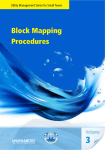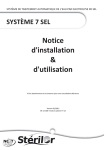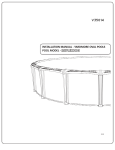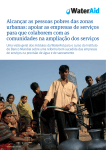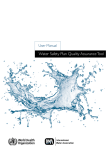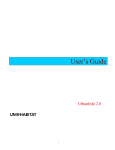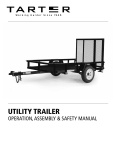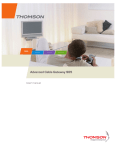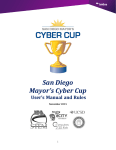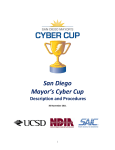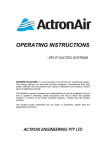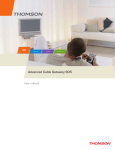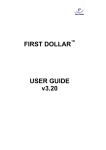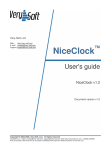Download Reduction of Illegal Water. Volume 6
Transcript
Utility Management Series for Small Towns Reduction of Illegal Water Volume 6 Reduction of Illegal Water Copyright © United Nations Human Settlements Programme 2012 All photographs © UN-Habitat HS/125/12E ISBN (Series) 978-92-1-133404-3 ISBN(Volume) 978-92-1-132538-6 All rights reserved United Nations Human Settlements Programme (UN-Habitat) P.O. Box 30030 - 00100 Nairobi GPO Kenya Tel: 254 20 7623120 (Central Kenya) Website: http://www.unhabitat.org Email: habitat.publications.org Disclaimer The designations employed and the presentation of the material in this publication do not imply the expression of any opinion whatsoever on the part of the Secretariat of the United Nations concerning the legal status of any country, territory, city or area, or of its authorities, or concerning delimitation of its frontiers or boundaries, or regarding its economic system or degree of development. The analysis, conclusions and recommendations of this publication do not necessarily reflect the view of the United Nations Human Settlements Programme, the Governing Council of the United Human Settlements Programme, or its Member States. Acknowledgements Principal Authors: UN-Habitat Lake Victoria Water and Sanitation Initiative team and National Water and Sewerage Contributors: Editor: Design and Layout: Corporation team Robert Goodwin, Rose Kaggwa and Anne Malebo Lake Victoria Water and Sanitation Initiative team Anne Musotsi Utility Management Series for Small Towns Reduction of Illegal Water FOREWORD Municipal authorities and urban service providers are being increasingly challenged to deliver sustainable services in a rapidly urbanizing world with complex problems resulting from the interplay of climate change, resource constraints and the adverse effects of a sluggish world economy. The need to improve the coverage and efficiency of urban basic services, such as water supply, sanitation, energy, drainage and transportation, has never been greater. It is now well recognized that the essential pre-condition for improvements in the delivery of urban services, is to establish effective and well run institutions within the framework of a policy environment that promotes investment, a commercial approach to service delivery, managerial autonomy and accountability to key stakeholders, including customers and the Government. With its mandate to promote sustainable urbanization, UN-Habitat has been in the forefront of international efforts to build the capacity of urban water utilities to face the challenges of expanding access to water and sanitation while improving the efficiency of service delivery. Through its regional and national programmes and the Global Water Operators Partnership Alliance, UN-Habitat provides capacity building for urban water utilities with a focus on business planning, water demand management, improving billing and revenue efficiency, energy audits and planning for climate change adaptation. iv The Lake Victoria Region Water and Sanitation Initiative is one of the regional programmes in Africa that has demonstrated the effectiveness of integrating capacity building for urban water utilities with modest investments to improve infrastructure. The first phase of the Initiative has now been completed with impressive improvements in extending access to water and sanitation while enhancing the managerial capacity and operational efficiency of the utilities in the ten pilot towns in Kenya, Uganda and Tanzania. The utilities which have benefited from the capacity building programme have experienced significant improvements in performance in key areas such as revenue enhancement, an expanded customer base and reductions in non-revenue water. The six training manuals which are included in this Compendium of Training Materials are based on the practical experience of delivering the capacity building programme for urban water utilities in the Lake Victoria Towns. They encompass the key areas of utility management and operations and it is hoped that they will contribute to the knowledge base of training approaches and best practices in the water utility sector in small urban centers. Joan Clos Under-Secretary-General, United Nations Executive Director, UN-Habitat v PREFACE Small water utilities face unique challenges in delivering water and sanitation services to their customers. With a limited revenue base and few opportunities to benefit from economies of scale, they often suffer from severe skill shortages and a long legacy of underinvestment in infrastructure and capacity enhancement. To overcome these challenges, the small utilities need to maximize their operating efficiencies and ensure optimum utilization of their assets. Since the year 2006, UN-Habitat has been working with national and regional partners in East Africa to implement the Lake Victoria Water and Sanitation Initiative (LVWATSAN) which seeks to address the water and sanitation needs of small secondary towns in the Lake Victoria Basin. A capacity development programme in utility management and operations has become an integral component of this Initiative, which was started in 10 towns and is now being expanded to another 15 towns in the 5 East African Countries which share the Lake Victoria Basin. The implementation of LVWATSAN has generated a solid body of knowledge and experience in enhancing the capacity of small utilities to improve their financial viability and operating efficiencies. This experience has been applied to produce a series of Manuals which can be used as training materials to improve the operating performance of small utilities. vi The Block Mapping Procedures Manual is part of a Compendium of Training Manuals for Small Water Utilities, produced by UN-Habitat in six (6) volumes, as follows: Volume 1: Finance Policies and Procedures Manual Volume 2: Customer Services User Manual Volume 3: Block Mapping Procedures Manual Volume 4: Water Audit Manual Volume 5: Leakage Control Manual Volume 6: Reduction of Illegal Water Use Manual The Manuals were produced through a collaborative effort between UNHabitat and the National Water and Sewerage Corporation of Uganda within the framework of a fast track capacity building programme in utility management and operations which targeted seven small utilities in the towns around Lake Victoria. Robert Goodwin Unit Leader, Water and Sanitation Urban Basic Services Branch UN-Habitat Nairobi, Kenya vii ABBREVIATIONS AND ACRONYMS CA HDPE pipes hNi Km LRP L L/D Litres M Mm MNF NWSC NRW Psi P UFW IURU ES DWD ET TOR PIPs QMS No. Shs. M&E viii Cooperation Agreement High-Density Polyethlyne pipes Large Networks Kilometer Leak Detection Programme Leakage Rates Length/Diameter ratio Litres Meter Mili meters Minimum Night Flow National Water and Sewerage Corporation Non-Revenue Water Pounds per Square Inch Pressure Unaccounted For Water Illegal Use Reduction Unit External Services Directorate of Water Development Expert Team Terms of Reference Perfomance Improvement Programme Quality Management Systems Number Shillings Monitoring and Evaluation GLOSSARY Water losses The difference between system input and authorized consumption. water losses can be considered as a total volume for the whole system, or for partial systems such as transmission or distribution schemes, or individual zones. Water Losses consist of physical losses and commercial. Commercial losses T Includes all types of inaccuracies associated with customer metering as well as data handling errors (meter reading and billing), plus unauthorized consumption (theft or illegal use). T Commercial losses are at times called Apparent Losses or NonTechnical Losses. Unauthorized consumption T Any unauthorized use of water may include illegal water withdrawal from hydrants (for example for construction purposes), illegal connections, by-passes to consumption meters or meter tampering. T Unauthorized consumption of water is what is popularly known as illegal usage of water ix CONTENTS x Foreword Preface Figures and Plates Abbreviations & Acronyms Gossary iv vi vi viii ix 1. Introduction 1.0 Background 1.1 Rationale 1.2 Scope and Objectives 1.3 Manual outline 1 1 3 3 4 2 Operating procedures 5 2.0 Benefits of Institutionalizing an Ilegal Use reduction Unit 6 2.1 Categories of Illegal Usage Cases 2.1.1 Meter By - Pass 2.1.2 Illegal Connection 2.1.3 Illegal Reconnection 2.1.4 Fetching water at a point before the meter 2.1.5 Meter reversal 2.1.6 Meter Tampering 6 6 8 9 9 9 10 2.2 Practical reduction of Illegal Use of Water 2.2.1 Institutionalizing an Illegal Use Reduction Unit 2.2.2 Illegal Use Reduction Policy 2.2.3 Publicity and Amnesty 10 10 10 11 2.2.4 2.2.5 2.2.6 Reward mechanism for informers Fines Payment Agreements 13 13 14 2.3 Identification and investigation of Illegal Use Cases 2.3.1 Procedures for identification and investigation of Meter By passes 2.3.2 Procedures for the identification and investigation of Illegal Connections 2.3.3 Procedures for the identification and investigation of Illegal Reconnection 2.3.4 Procedures for the identification and investigation of fetching before the Meter 2.3.5 Procedures for the identification and investigation of Meter reversal 2.3.6 Procedures for the identification and Investigation of Meter Tampering 14 2.4 Steps to be taken for illegal cases identified 23 2.5 Technical corrective or preventive interventions for the different illegal connections 2.5.1 Meter By pass 2.5.2 Illegal Connection 2.5.3 Reconnection 2.5.4 Fetching before the meter, meter reversal and meter tampering 3. Key Result Areas and Performance Indicators 3.1 Key Result Areas 3.2 Performance Indicators 3.3 Monitoring and Evaluation of Indicators 16 18 19 19 20 22 25 25 25 26 26 27 28 28 28 xi 4. Requirements 4.1 Equipment 4.2 Human Resource 4.2.1 Skills 4.2.2 Responsibilities APPENDICES Appendix 1 Appendix 2 Figures Figure 1: Figure 2: Figure 3: Figure 4: Figure 4: Plates Plate 1: Plate 2: Plate 3a& b: xii Sample form of illegal water connection Monthly report An illustration of a meter by pass Sketch showing a typical meter by pass Flow chart for procedures for identifying a meter by pass or illegal connection A sample receipt for illegal use Example of a sample form for illegal use 30 31 31 31 32 33 33 34 7 17 21 24 33 Plate 4: Plate 5: Examples of meter by passes in the field An illegal connection made onto the network A connection that allows a customer to fetch water before the meter and b) An example of what a reversed meter shows Typical example of a suspected illegal connection Example of a meter that has been reversed 7 8 9 19 22 Tables Table 1: Perfomance indicators for illegal use reduction 28 CHAPTER 1 Background Investigation of house water connections. Photo © UN-Habitat W ater Utilities have an important responsibility to provide safe and reliable supplies to their customers. Consumers, on the other hand also have a responsibility to ensure that their use of water is legal and is governed by a formal agreement with the Utility. Water audit is an excercise that determines the water supplied, consumed and lost in the distribution system. This infrmation is useful it helps many urban water utilities to make effective O&M as well as investment decisions. which in turn results in poor operating efficiencies and weak finances. Illegal water use takes many forms, including unauthorized connections to the water network and meter tampering. Illegal water use reduction cannot be handled in an ad-hoc way but should form an important component of a Utility’s programme to reduce UFW and maximize revenues and operating efficiencies. The Lake Victoria Region Water and Sanitation Initiative has provided many useful lessons on the procedures and systems to the followed in addressing the problem of Illegal Water Use. One of the key lessons learnt is that illegal water use is a serious problem for many small urban utilities and unless it is brought under control, it will be difficult for these utilities to achieve financial viability. Another important lesson is that illegal water use should be addressed in a systematic way and should be well integrated into an overall programme of UFW monitoring and control. Small urban utilities, with all the challenges that they face, cannot afford to lose water through illegal connections, meter tampering and other forms of illegal water use. They are encouraged to systematically confront this problem by adopting the procedures outlined in this Manual. 2 1.1 Rationale The rationale for preparation of the manual is to have documented and streamlined procedures for implementation of activities. The documented procedures are to ensure that staff carries out their roles and responsibilities with minimum supervision and new staff quickly copes up with the requirements for their jobs. This conforms to the overall water sector perspective of designing and implementing Quality Management Systems (QMS). 1.2 Scope and Objectives The scope of this illegal use reduction manual shall cover all the different categories of illegal connections normally found in consumer premises and the procedures/guidelines for their investigations and identification. The objectives of the Illegal Use Reduction Unit include the following: i. To reduce illegal consumption through proactive, effective and comprehensive identification & investigation of illegal water consumers in the water supply area(s). ii. To devise and establish mechanisms that will compel the identified illegal consumers to desist from reverting to the bad practices of illegal consumption. iii. To maximize collection of fines that has been levied on the identified illegal consumers. 3 1.3 Manual outline Chapter one entails the background, rational, scope and objectives of the manual. It also explains the circulation, control of the manual and a manual amendment procedure. Chapter two discusses the operating procedures which is the main purpose of this manual. Chapter three entails the key result areas and the performance indicators that help the management to set realistic targets for the implementing team, and aid decision making as well. Chapter four details the logistics required for implementation, this also includes the human resource, equipment and or skills and abilities required for the key team. 4 CHAPTER 2 Operating Procedures Water pipe mantenance. Photo © UN-Habitat 2.0 Benefits of Institutionalizing an Illegal Use Reduction Unit i. Reduction of illegal consumption reduces Non Revenue Water. ii. Reduced Operational costs– less chemicals and electricity – optimized production. iii. More water availed for legal consumption. iv. Increased revenue through the fines levied on the identified illegal consumers. v. Better Planning - reliable demand projections. vi. Optimized operation of the distribution system. 2.1 Categories of Illegal Usage Cases 2.1.1 Meter by - pass i. The consumer is a customer, with a meter. ii. The customer has an alternative pipe taping water before the meter. This water may simply by pass the meter to roof tank T direct to the house T to the garden or a combination of two or the three cases (see Figure 1). 6 Figure 1 An illustration of a meter by pass Ball Valve Customer’s Water Tank Distribution control valve Distribution line Water Meter Stopcock 3 1 2 Meter by pass To Garden/Yard Tap Plate 1: Pictures of a meter by passing in the field 7 2.1.2 Illegal Connection T The consumer is not even a customer to the water supply system. T They have simply connected themselves to the network (Plate 2) Plate 2: An illegal connection made onto the network 8 2.1.3 Illegal Reconnection The customer has been disconnected for non-payment, but they go ahead and reconnect themselves to the network. 2.1.4 Fetching water at a point before the meter The customer consumes water that is not metered by closing the stop cork, removing the meter then they connect a horse pipe to the network and fetch water. After they have fetched water they return the meter (Plate 3). 2.1.5 Meter reversal The customer installs the meter in reverse order so that it counts backwards to a desired reading. When satisfied they turn the meter to the correct position. Meter reversal may entail reversing the meter readings manually. Plate 3a & b: Pictures of meter reversal a. A connection that allows a customer to fetch water before the meter b. An example of what a reversed meter shows 9 2.1.6 Meter Tampering The customer intentionally corrupts the meter so as to affect its efficiency. This may include; reducing or distorting mechanical gears, boiling meter so as to melt internal components, breaking meter reading glass, introducing impurities etc. 2.2 Practical reduction of Illegal Use of Water 2.2.1 Institutionalizing an Illegal Use Reduction Unit The first step in addressing illegal usage of water is institutionalizing an illegal use reduction frame work. The procedures that can be adopted to institutionalize the framework include: 2.2.2 Illegal Use Reduction Policy Develop an Illegal Use Reduction Policy. The top management together with the technical team should develop this policies / stand of the water supply system concerning illegal usage of water. For instance it is illegal for any consumer to; T By pass a meter, T Reconnect themselves if disconnected due to non payment T Reverse a water meter T Tamper with any meter (If a customer feels that a meter is not functioning well) they should simply report the matter to the service provider. The service provider shall not be liable for any 10 meter tampered with by anybody other than the authorized staff T Connect themselves to the network (illegal connection) T The penalties should as well be defined for instance if caught with any offence you will be charged 200Dollars as a fine, in addition customers will pay •100 Dollars if the offence is an illegal connection, •70 Dollars if it’s a reconnection offence, •150 Dollars if the customer tampered with or reversed the meter, •An equivalent of 12 month average consumption if the offence is a meter by pass and •An equivalent of 24 month of estimated average consumption if the offence is illegal connection The policy has to be very clear and practical. Also not that the fines should be a little high (In Uganda the fine is about 200 dollars) because a fine is supposed to be a deterrent (to prevent people from doing wrong, otherwise if it is low people will not be scared as they can easily pay if caught. 2.2.3 Publicity and Amnesty Publicity After developing a policy, it is important to notify the public about your position as a water service provider on the issue of illegal use of water. This can be done through all the modes of communication i.e. 11 Radio announcements, public gatherings, news papers and distribution of fliers. Amnesty After the community has understood your position on illegal usage, the next stage is to start cleaning up. The number of people of illegal cases may be so many that dealing with each of them legally may be uneconomical. Amnesty is therefore paramount at this stage. An amnesty period of three month is realistic, during which customers who declare that they have illegal connections will not be penalized. For instance give the following conditions, the customers can be advised to: i. Illegal Connection – Apply for a new connection, avail all necessary documents and then we shall formalize the connection. ii. Illegal reconnection – you will be excused from the fines – you will simply clear your water bill to zero iii. Meter By Pass – We shall simply remove the meter by pass (But relocate the meter to out of the premise if safe or close to the perimeter wall – to minimize the temptation) iv. Meter tampering – you will pay a small fee for replacement of the meter (Quote the cost of the meter) v. Meter reversal and fetching before the meter - We shall correct the meter position (But remove stop cork for such a customer as well) – Stop corks give the customers ample time to close 12 off water , remove and reverse meters and or fetch before the meter Ensure that the publicity is sound so that information reaches the entire service area for positive results. 2.2.4 Reward mechanism for informers Once the amnesty period expires, it is important to start the hunt. Much as the sole responsibility of tracing for illegal cases falls on the illegal use reduction team, they can never comb the entire area. Informers are handy when it comes to reporting these cases. A clear reward mechanism should be put in place. A provision of funds should be put in place preferably in form of replenish-able imp rest to facilitate quick payment of rewards. Note that the informers are simple people who need cash, so be sure to have cash for them at all times (The given sum arrived at from experience should be available) 2.2.5 Fines The penalties should as well be defined for instance if caught with any offence you will be charged 200 US $ (United States Dollars) as a fine, in addition customers will pay. T 100 US$ if the offence is an illegal connection, T 70 US$ if it’s a reconnection offence, T 150 US$ if the customer tampered with or reversed the meter, 13 T An equivalent of 12 month average consumption if the offence is a meter by pass and an equivalent of 24 month of estimated average consumption if the offence is illegal connection Note that estimation of consumption should be objective; otherwise you may end up with a lot of uncollected fines/revenue. 2.2.6 Payment Agreements Where customers can not pay off fines at once, agreements should be signed with the culprits with clear install payments on monthly basis. The monthly amount should be realistic otherwise the system will be frustrated since the customer in addition has to pay for the current consumption. The date for the monthly payment (e.g. every 30th day of the month) should be indicated as well in the agreement for proper monitoring of the system. To enhance monitoring of the install payment, a computerized system should be designed to ease verification on regular basis (daily or weekly) 2.3 Identification and investigation of Illegal Use Cases Before carrying out any investigation, information concerning the pipe network is very important. Have as much information about the network as possible; otherwise you might waste valuable time if you are not investigating from a known point. To ease your/cut down on 14 the number of accounts to visit, ensure that you have helpful lists such as: i. List of Target/suspicious customers generated from data base querying ii. Bad History customers - customers who once had an illegal problem with the water service provider (Theft is a habit, so keep record of all defaulters and keep revisiting them at least after every 4 month). iii. Suppressed accounts – List of customers who were cut off supply but have not returned to pay for the service and get reconnected (everyone needs water – so do not assume that these people are off supply (revisit and investigate them. iv. List of people who once applied for water but did not complete the new connection process for one reason or another. (By the time one applies for water, they really need it. Their not coming back may imply that the applicant got a cheaper option of getting water. So ensure that you acquire sufficient contact details for whoever expresses interest in water. v. List of customers who are supposed to be off supply. Ensure 100% investigation of reported/suspected illegal consumption cases (All suspect and reported cases must be investigated) 15 2.3.1 Procedures for identification and investigation of Meter By passes In order to identify and investigate a meter by pass the following steps should be taken: i. Close the stop cock, feel the pipe just before the meter, if there is a vibration in the pipe, then there is reason to suspect a meter by pass as water flow induces a vibration in the pipe. ii. Check the water tank; press the ball valve down to see if there is water inflow. No water is expected to reach the roof tank once the stop cork is closed. Presence of water implies that there is a meter by pass iii. Close off the distribution lines from the tank and check taps in the house. No water is expected, presence of water implies that there is a by-pass. Note however that when these taps are opened there may be back flow from the pipe between the tank and the tap for about 1 minute. iv. Now reverse the above process, Open all the lines to ensure full water supply, on doing this all taps should be receiving water. If there is any tap that does not receive water it is very likely 16 that it is an illegal line (it implies that a gate valve has been closed). v. Now check if the direct lines (commonly the garden tap and or the kitchen line) still receive water. vi. At this stage we do not expect any water at any tap at all. vii. Reverse the process and check the taps which don’t have water. Note that all taps should be having water after opening the taps. If there is a tap without water, it implies that a control valve has been closed. Figure 2 Sketch showing a typical meter by pass Ball Valve Customer’s Water Tank Distribution control valve Distribution line Water Meter Stopcock 3 1 2 Meter by pass To Garden/Yard Tap 17 2.3.2 Procedures for the identification and investigation of Illegal Connections Revisit all customers who once applied for water and did not complete the process. It may be because they got a cheaper option of getting connected to the water network (illegal connection). Use informers – these are handy. You must be able to pay them cash, as this category of people need money for survival on a daily basis. Use Local leaders – you may have an arrangement with the local leader to record for you new connections in their respective areas per month (say an incentive of 300 shillings per new connection reported), then reconcile the new connections reported with those that were connected as per your records (illegal cases will then be identified). In cases where universal metering has not been achieved, it is important to ask customers who are on supply without meter and are suspected to be illegal connections for at least a water bill. If nothing is available then confirm that it is an illegal connection. 18 Plate 4: Typical example of a suspected illegal connection 2.3.3 Procedures for the identification and investigation of Illegal Reconnection Make a list of customers who are supposed to be off supply. Reconnections are common in the evening and during the week ends when the customers do not expect the service provider to visit them at all. So revisit these customers at the appropriate time. 2.3.4 Procedures for the identification and investigation of fetching before the Meter Make a list of customers whose consumption is inconsistent and those whose consumption is too low. Fetching before the meter is common in the evening and during the week ends when the customers do not expect the service provider to visit them at all. So revisit these customers at the appropriate time. 19 2.3.5 Procedures for the identification and investigation of Meter reversal Ensure that arrows on the meter point in the direction of flow; otherwise it implies that the meter has been reversed. The position of the stop cork also suggests the direction of flow. Conventionally, the stop cork is at the upstream part of the flow direction (Before the meter). However be careful to note if the stop cork is indeed before the meter because there are instances where stop corks are placed after the meter to prevent meter tampering. Another indicator of a meter reversal is a lower reading than previous reading. Figure 3 shows a typical flow chart of the steps to take when identifying an illegal connection or meter by pass. Another way of identifying these cases is through sampling meter readings (meter reading audits). Pick on a set of customers and monitor their customer meter readings several times through the month. Once a reduction is noticed this should be reported as an illegal case of meter reversal. 20 Figure 3 Flow chart for procedures for identifying a meter by pass or illegal connection Carry out field visit collect all primary data Is the consumer a customer? Most likely not Are there any legal documents? No An illegal consumer = illegal connection Yes 1. Notify customers of the offence and penalize them 2. If possible formalize connection END OF INVESTIGATION 1. Close Stop cork 2. Close distribution lines if customer has roof tank 3. Press ball valve in roof tank down Is there water in the roof tank? Yes Water in the tank implies a meter by-pass before meter to feed the roof tank No No by pass to roof tank Open all water taps and allow to run for 1 minute to drain all pipes Is there water running in the taps? Yes Implies a meter by-pass before meter Trace/pin point and expose point of tapping No Open stop cork & distribution lines Are all taps receiving water? No Tap not receiving water is on the meter by pass line. A control valve somewhere is closed Yes If all taps get water then there is no meter by-pass END OF INVESTIGATION 21 Plate 5: Example of a meter that has been reversed 2.3.6 Procedures for identification and investigation of meter tampering Meter tampering includes physical or manual reversal of the meter readings. Signs of a meter that has been tampered with include: T a shiny body of water meter implying that it is being held every now and then. T loose fittings at the meter connection, implying that the fittings are opened so often – an evidence of leaking at the fittings. T pipe wrench marks on the fittings. 22 2.4 Steps to be taken for identified illegal cases Action 1. Summarize findings on a form indicating the kind of illegal offense discovered at the property. Complete two copies of the form and return one to office. Leave the second form at the customers’ premise that indicates clearly the contacts of the illegal use reduction Unit office. A sample of such a form is shown in Figure 3. This report must be endorsed by the manager. (See Appendix 1 for a typical form used in NWSC – Kampala Water). Action 2. Disconnect the customer from the taping point from the main so as to avoid the customer reconnecting themselves. Action 3. Compute the fines and write a letter to the customer informing them of the fine that has been levied to them. In the letter invite the customer to the office for further discussion. These letters should be in accordance with the Law and should be signed by the Commercial Manager and copied to the Managing Director and Billing Clerk (s). Action 4. If the customer cannot pay the entire fine at ago, sign a payment agreement with them. Action 5. Follow up and collect all fines levied. Payment of all fines shall be made at the designated Cash office(s). Action 6. Effect reconnection of paid up customers upon issuance of reconnection orders by the Commercial Manager. Reconnection orders should be copied to the Billing Clerk(s). 23 Figure 4 A sample form showing illegal use No. PROPERTY REFERENCE DATE OF REPORT ZONE REPORTED BY CUSTOMER NAME PROPERTY REFERENCE CUSTOMER REFERENCE OFFENCE IC IR MBP MTW MS OTHERS ORDERED BY ANY RELEVANT REMARKS NAME SIGN BLUE - I.U.R.P., YELLOW - ZM, GREEN FOR RECORD Be ver veryy sspec peciifficwhen whenyou youmention mentionthe thenature natureofofthe theoffence: offence: Be IC=Illegal Connection, i.e. when the customer has no supporting documents and no meter IR: Illegal Reconnection, i.e. when the customer reconnects himself after disconnection MBP: Meter By-Pass MTW: Meter Tampered with MS: Meter Reversed 24 2.5 Technical corrective or preventive interventions for the different illegal connections 2.5.1 Meter By pass Relocate metering point out of customers premise if safe or install meter as close as possible to the perimeter wall. This lessens the length of pipe available to the customer’s disposal therefore reducing illegal usage. 2.5.2 Illegal Connection T Continuously use informers T Regularly revisit people who once applied for water and did not return. T Ensure 100% / universal metering to avoid confusion in the system – existence of legal unmetered accounts may at times work against the service provider as it may be difficult to easily identify the illegal cases. T Follow up suppressed accounts (People who have been disconnected for no payment and have not returned). T Carry out water network patrols especially in areas where mains intensification and extension have been carried out with a view of identifying possible illegal connections on such new mains. 25 2.5.3 Reconnection Carry out effective disconnection of customers whenever you are disconnecting them. Effective disconnection is from the distribution main and not at the customers metering point. 2.5.4 Fetching before the meter, meter reversal and meter tampering T Use lockable chambers T Use strong metallic clamps T Remove all stop corks (the presence of stop corks gives customers ample time to stop the water, remove and tamper with meter). 26 CHAPTER 3 Key Result Areas and Performance Indicators Leak detection demonstration. Photo © UN-Habitat 3.1 Key Result Areas T Devise and establish mechanism for identification of illegal consumers T Maximise collection of fines levied on identified illegal consumers T Reduce illegal consumption. 3.2 Performance Indicators To effectively carry out illegal use reduction, the following performance indicators need to be determined. Table 1: Performance Indicators for Illegal Use Reduction No. Performance Indicators 1 Investigation to unearth illegal connections carried out 2 Illegal connections identified 3 Total amount of fines invoiced to illegal consumers 4 Amount of levied fines collected 5 Percentage amount of levied fines collected 6 No of disconnections of illegal cases effected 7 No of reconnections of illegal cases effected. Unit No. No. Shs Shs % No. No. 3.3 Monitoring and Evaluation of Indicators The monitoring and evaluation (M&E) during the implementation of the illegal use reduction tasks shall be through the M&E sub-committees in charge of specific zones. The sub-committees will regularly move, at 28 an interval to be determined by management, around the network to verify activities of the illegal use reduction unit. The illegal use reduction unit shall be required to keep records of quantifiable performance indicators to facilitate verification by the sub-committees. The sub-committees will then meet with the respective zonal staff of the illegal use reduction unit on a weekly basis to discuss constraining issues and strive to find solutions. The entire M&E team will then meet bi-weekly to have a holistic overview of the implementation status. At each stage of the meeting, the agreed way forward on the constraints and achievements will be communicated to the respective operating zones. The evaluation of the performance of the illegal use reduction unit shall be carried out at the end of each month and each sub-committee shall highlight constraints experienced and proposed way forward, which are then discussed in a meeting chaired by the illegal use reduction Incharge. 29 CHAPTER 4 Requirements Water pipes mantenance and illegal water reduction exercise. Photo © UN-Habitat 4.1 Equipment These facilities are used to pin point location of pipe after confirmation of a fraud existence i. An up to date block map ii. Tools e.g. pick axes, spades and hoes iii. A set of assorted equipment are used for locating pipes, these include; metallic pipe locator, plastic pipe locator (hammer plus noise leak detector) and a Geo radder. Where the assorted equipment is not available, items 1 and 2 can be used. The location of fraud pipe will be based on try and error. This makes the map and knowledge on the network very handy. 4.2 Human Resource 4.2.1 Skills The general skills required for the illegal Use reduction team leader include; T Ability to use the assorted equipment and train others T Ability to analyze data - for fishy consumption patterns T Integrity is key as the challenge of bribes is expected. T Understanding of the pipe network is very important as the water facilities are buried. T Assertiveness / boldness are very important – note that the team will be dealing with wrong people/ thieves. 31 4.2.2 Responsibilities Set up of basic framework (these first 3 responsibilities will be short leaved but are very important for a successful launch of the program) T In liaison with top Management develop a policy that will address the offences this should be passed by the Government as well. T Spear head educating the public about the law, offences and corresponding penalties or fines. T Spear Head the issue of amnesty to the defaulters /culprits Post/After Amnesty T Monitor and advice management on the usage/ abuse of fire hydrants. T Conduct / coordinate meter reading audits to check for meter reversal cases, conspiracy and quality of meter readings. T Generate list of suspicious consumers, customers i.e customers who once applied for a new connection and are not yet connected, customers who are supposed to be off supply, customers with suspicious consumption patterns. T Prepare a schedule for field work and assign work to the different field staff T Be a custodian for all field date, evidence etc. T Manage agreements signed with defaulters. 32 Appendices Appendix 1 Figure 5 Sample of an illegal connection form for water utilities WATER SUPPLY AND SEWERAGE SERVICE AREA Company’s Logo OPERATED BY (NAME) WATER COMPANY ILLEGAL CONNECTION NOTICE (OFFICE COPY) Serial No. Property Reference No. Date Customer Reference No. Zone Disconnection Executed by Nature of illegal consumption In Witness of 1. Illegal Connection Zone Manager 2. Illegal Reconnection Customer Name 3. Meter By-pass Customer Phone 4. Meter Tampered with Estimated Meter by Consumption Tarrif 5. Other DOMESTIC COMMERCIAL m3 ... GOVMST PSP Serial No. ILLEGAL CONNECTION NOTICE Property Ref Date Customer Ref Customer Name Physical Address This is to bring to your attention that our investigation at your premises has revealed that you have: A An Illegal Water Connection B. An Illegal Water Reconnection C. A Meter By-pass D. A Meter Tampered with E. Other Consequently, we are disconnecting the above premises from our water supply network and request that you approach our offices at ( office location) - within 24 hours. Please note that according to the THE WATER GENERAL RATES ORDER, 2002 SECTION 4 you are liable to a fine of (currency) (amount) plus an estimate charge for water consumed in the previous 24 months. PLUMBER Signature Witnessed By SUPERVISOR Signature Signature 33 Appendix 2 Monthly report A concise monthly report on illegal use reduction shall be prepared by the illegal use reduction unit. The report shall include; T Suspected illegal consumption Cases T Confirmed cases of illegal consumption T Total amount of fines invoiced to illegal consumers T Amount of levied fines collected T No. of reconnections and disconnections of illegal cases effected T Main constraints and challenges faced T Proposed way forward T Any other information that is required by management. 34 This manual is part of a Utility Management Series for Small Towns. It can be used either as a training module to support the delivery of capacity building programmes in utility management and operations or as a reference manual to guide operations and maintenance staff in designing and implementing programmes to reduce the rate of Unaccounted-For-Water. When used by urban water utilities, the manual should be widely circulated to ensure that all staff and Supervisors involved/working in concerned Departments/Sections receive a copy. This will ensure a systematic and consistent approach to the implementation of an Illegal Water Use Reduction Strategy. HS/125/12E ISBN (Series) 978-92-1-133404-3 ISBN(Volume) 978-92-1-132538-6 UNITED NATIONS HUMAN SETTLEMENTS PROGRAMME P.O. Box 30030, Nairobi, Kenya Tel: +254-20-7624910; Fax: (+254) 207623588 [email protected] www.unhabitat.org/publications 35















































